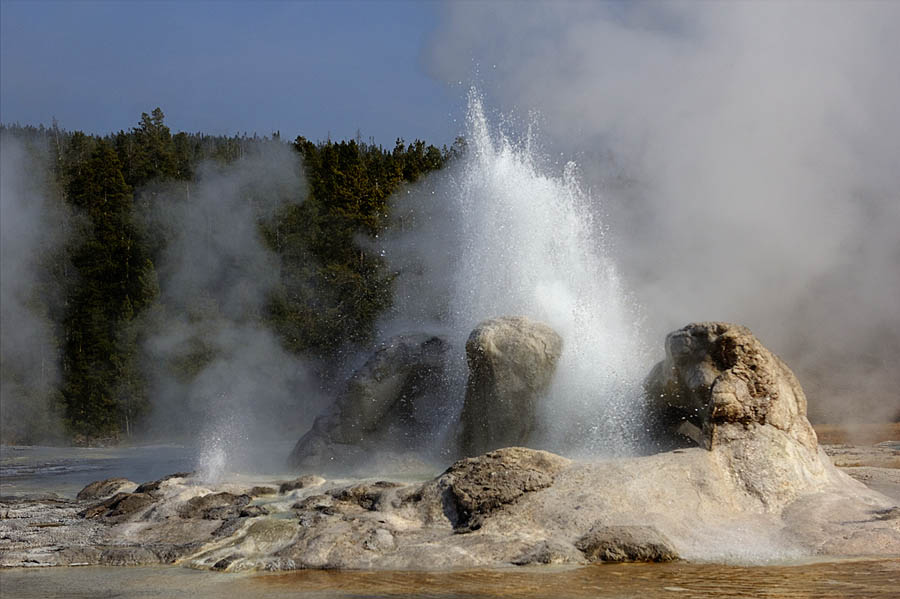
By Janet White
The geysers and other thermal features of Yellowstone National Park make up a vast, complex and dynamic collection of constantly changing natural wonders. A wide range of amateur hobbyists and professional geologists and hydrologists regularly track the activities and changes in Yellowstone’s thermal features and post their findings at various sites online. Here’s a look at what has been going on in September:
On Geyser Hill
September 2012 saw Plume Geyser stop erupting for the second time this year. The last known eruption was on the morning of September 6. While no eruptions have been seen since, constant gurgling lets us know the water isn’t terribly far below the surface. Listen to the gurgling of Plume Geyser here.
Beehive Geyser seems to be averaging an eruption once every 12-17 hours. About 15 hours is a good guess to have for the center of an unofficial prediction window. Most daytime eruptions are caught on the live streaming webcam and can be a nice break during the work day.
Aurum Geyser has had a few 3- and 4-hour intervals between all the long intervals of 10 or more hours. That means it’s likely to shift into winter mode soon.
Aurum Geyser is strongly affected by the amount of water in the system. In spring, when the runoff hits, it shifts to long intervals between eruptions, and as things dry out in the fall, Aurum begins to quicken its pace.
Giantess Geyser, which often erupts at least once or twice a year, has remained quiet for over a year now. The last eruption occurred on September 13, 2011.
Elsewhere in the Upper Geyser Basin
Grand Geyser continued to have unusually short intervals between eruptions. A majority of eruptions have been 5-6 hours apart with a few 7-hour intervals between eruptions tossed in to keep everyone guessing.
Fan and Mortar Geysers had a nice stretch of eruptions, and seems to be falling into a rhythm of erupting about every 4 days, but the reports say there may be little warning before building into a full eruption.
In late September, Grotto Geyser was in a “marathon” eruption—one that lasts for many hours. This gave a chance for Spa Geyser (located a bit farther down the path from Grotto Geyser) to fill and erupt with short, lasting bursts spaced a minute or two apart. Some bursts reached a 10-15 feet while others were only 2 -3 feet tall.
Lower Geyser Basin
September saw two more eruptions from Morning Geyser. One witnessed by geyser enthusiasts on the September 9 lasted 22 minutes. The other likely eruption was seen by one of Xanterra’s tour guides, who noticed the large eruption on September 24, a rainy day, and checked the times at Geyser Times.org to see if it could have been Fountain Geyser instead. The time listed for the last known eruption of Fountain was too close to the time of this large eruption to logically be Fountain. This all points to a very likely Morning Geyser eruption.
Eagerly Awaiting Monitor Data
For many years, Ralph Taylor, a volunteer for Yellowstone National Park, has conducted research on a select few geysers using electronic monitors that measure temperature. Past records are available online. By placing the sensors in locations where the water from geyser eruptions flow over them, they can detect the change in temperature, and an electronic record is created to show the times of eruptions. Data recorded in these monitors must be retrieved manually. This year, Taylor has not been in the park and Yellowstone geologists have taken responsibility for the electronic monitors. Last spring, when questioned about these data loggers, geyser enthusiasts were told the information would be retrieved in the fall.
As the summer season winds down, and we’re well into fall, many look forward to sifting through the information recorded this summer to learn more about what was recorded.
Janet White is the creator of GeyserWatch.com and appreciates any reports on unusual or interesting activities by Yellowstone Park thermal features.
